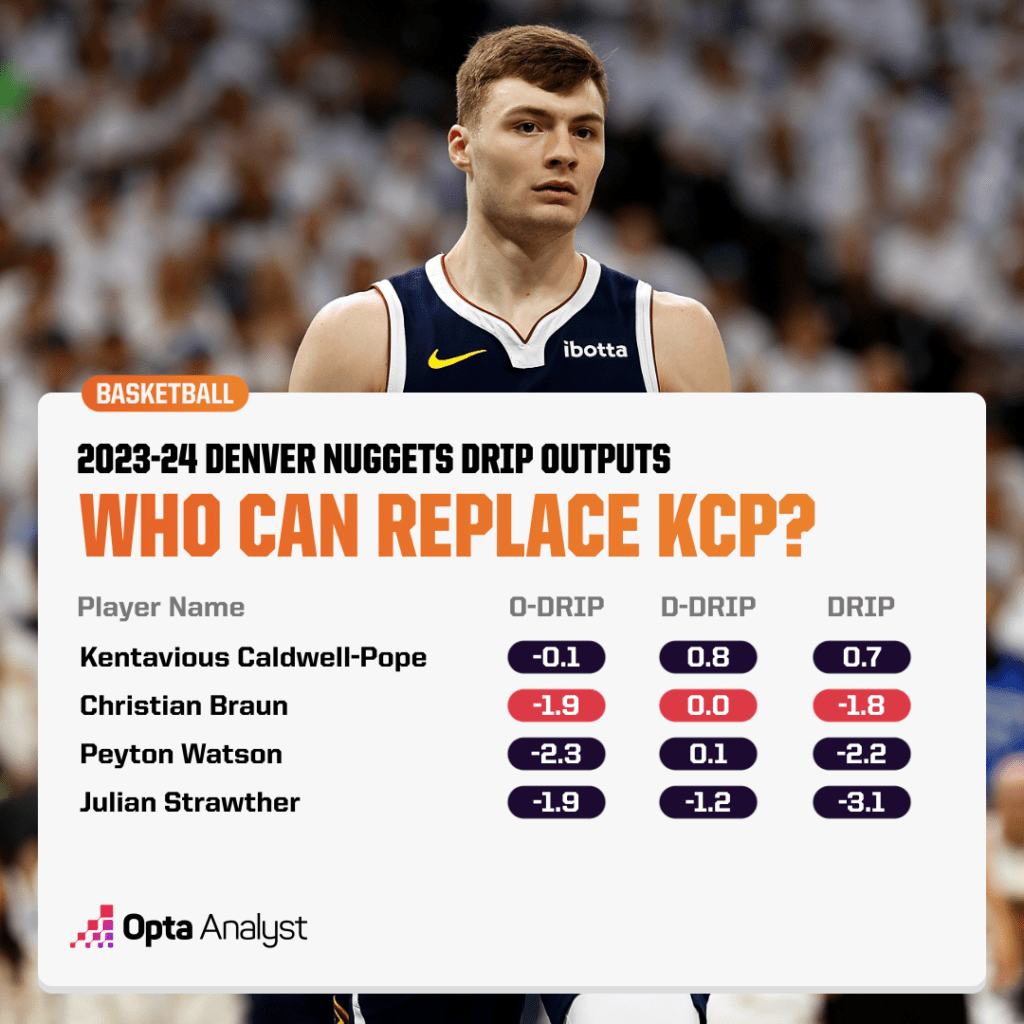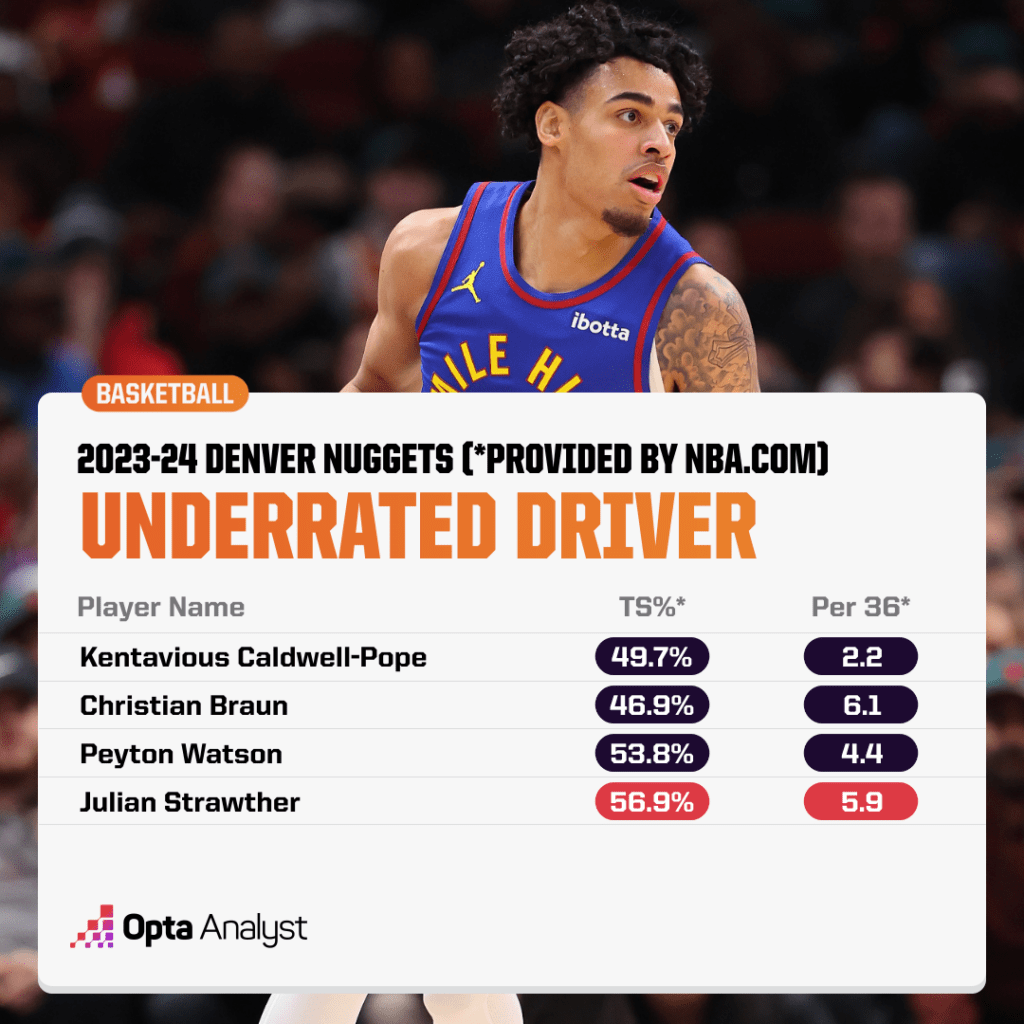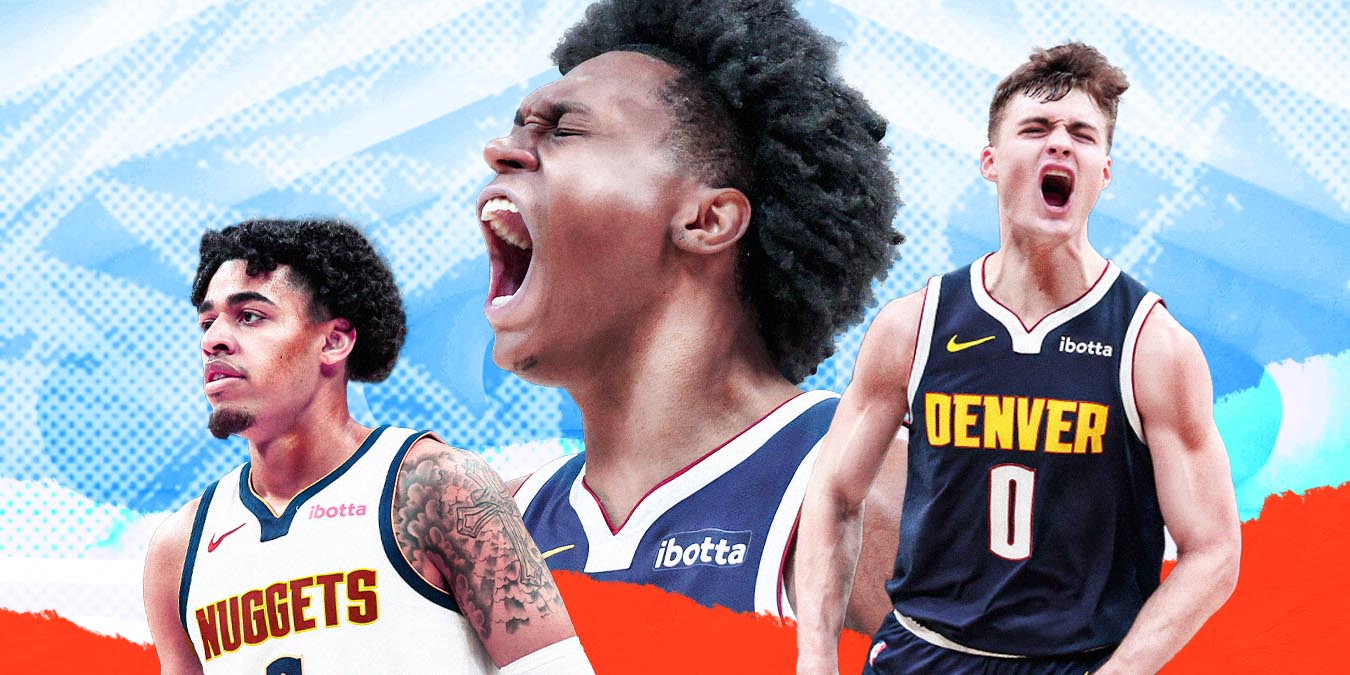If the Nuggets are going to remain in title contention, it will likely come down to their young trio blossoming into impactful players. But what are the odds of that happening? We examine the Nuggets’ 2024-25 outlook.
Since winning their first championship in 2022-23, the Denver Nuggets have allowed Bruce Brown, Jeff Green, and now Kentavious Caldwell-Pope (three of their top seven players in total minutes during the 2023 NBA playoffs) to walk in free agency.
All in the name of avoiding a hefty tax bill. Hell, they even parted ways with draft capital just to save a few bucks by getting off Reggie Jackson’s contract.
These moves are disappointing because the Nuggets have a strong nucleus – headlined by arguably the best player on the planet in Nikola Jokic – and with the right moves, they could ostensibly be competing for titles for years to come. However, the front office is limited by ownership’s clear prerogative to avoid paying the piper.
With that said, we’ve seen frugal franchises make deep runs before (have you ever seen the movie “Moneyball?”), and that is done by acquiring underrated players below their true market value.
Some could argue that they did that by adding Dario Saric and (soon) Russell Westbrook on light contracts. But at best, those gentlemen may be able to mimic the impact of Brown (Westbrook) and Green (Saric). That says nothing about who is going to fill the shoes of one of the best role players in the association in Caldwell-Pope.
Ultimately, if the Nuggets are going to remain in the title race in spite of ownership, it will come down to their young trio (who are all still on rookie-scale contracts) blossoming into impactful players in 2024-25.
The question now becomes: What are the odds of that actually happening?
(Sidebar No. 1: The Nuggets technically have a young foursome. Unfortunately, one head of the snake – DaRon Holmes II – is out for the season after suffering a torn Achilles during the Vegas Summer League.)
Christian Braun
Braun is the most obvious candidate to fill the shoes of Caldwell-Pope. He’s the most battle-tested of the troika (he already has 31 career playoff games under his belt), and he provides the best blend of two-way balance out of the three.
This is obvious when you look at DRIP outputs. Peyton Watson has a slightly higher defensive DRIP (plus-0.1) than Braun (0.0), but Braun has a higher lead offensive DRIP (O-DRIP). And while Julian Strawther has the same O-DRIP (minus-1.9), his defensive DRIP (D-DRIP) pales in comparison (-1.2).

Braun is a proven perimeter defender. Last postseason, he held the NBA’s favorite son, Anthony Edwards, to 4-of-12 shooting when he was guarding him (per NBA.com). That was one year after he relegated Jimmy Butler and Devin Booker to a combined 6 for 18.
He may not be as good at guarding slithery guards as Caldwell-Pope, but he’s arguably better at handling bigger/stronger wings/forwards. When you factor that in with the positional rim protection he offers (Braun was in the 55th percentile in block rate), he’s a worthy successor to Caldwell-Pope on defense.
To be fair, with Braun, defense has never been the concern. It’s the other end of the floor that leaves his ability to slot in for Caldwell-Pope up for debate. Braun hit 38.4% of his triples last season, but that was on volume that placed in the 27th percentile league-wide (3.6 3s per 100 possessions). Considering Caldwell-Pope shot 40.6% on 6.4 3s per 100, that’s a significant decline in terms of shooting/spacing.
Caldwell-Pope also used to lean on his midrange jumper when teams would try to run him off the 3-point line with a fly-by closeout. Last year, Caldwell-Pope hit 47% of his midrange attempts (71st percentile) – making him a threatening partner with Jokic in the two-man game.
Meanwhile, Braun did not flash the same potency – shooting 38.1% from the midrange (34th percentile).
With those differences in mind, there is hope that Braun can close the gap in Year 3. While he hasn’t done so yet in the NBA, Braun has demonstrated the ability to take more 3-pointers. In his three seasons at Kansas, Braun hit 37.8% of his 7.2 3s per 100. If Braun can bring that volume back (while staying at/near his current efficiency), it would make him a pretty meaningful spacer.
And while I don’t ever see Braun developing into the midrange master that Caldwell-Pope is, he could make up for it with his interior play-finishing. Braun is great at getting to the rim via transition forays or cuts – taking 34% of shots between 0-3 feet, which is nearly double Caldwell-Pope’s percentage (17.7%).
So, he can still operate in some form of two-man game with Jokic (as seen in the clip below). It will just look a little different than what we’ve grown accustomed to seeing.
Julian Strawther
While Braun is the most obvious option to replace Caldwell-Pope, Strawther may be the one with the highest upside. A big reason for that is because he has a skill that is hard to come by: the ability to light it up from the outside.
Don’t let his 3-point percentage from last year (29.7%) fool you. Strawther is a wickedly good marksman. In three seasons at Gonzaga, Strawther shot 38.4% on 9.3 3s per 100. During his first season in the NBA, he took 12.4 3-pointers per 100 (nearly double Caldwell-Pope’s volume and four times Braun’s), which was second among rookies who played at least 40 games (trailing only Jordan Hawkins).
Unlike Braun, Strawther also has the juice from the midrange. Strawther hit 48.7% of his middies (78th percentile) in Year 1. But what’s promising is how he accumulated a lot of these buckets.
A quick tour of the tape shows that Strawther has a burgeoning right-handed floater that he can turn to when attacking closeouts, coming off dribble handoffs, or running the pick-and-roll. Once fully fleshed out, this weapon will become another wrinkle in Denver’s dynamic offense.
Strawther also has more upside as a ball handler/driver than Caldwell-Pope and Braun (and Peyton Watson). His drive efficiency (measured by true shooting) was higher than all three of them, and his drive volume (measured by drives per 36) was higher than Caldwell-Pope and Watson’s and right near the rate posted by Braun.

At 6-foot-7 with a 6-9 wingspan, Strawther has the anatomical tools to be a good guard/wing defender. Rookies are hardly ever good (as evidenced by his DRIP above). So, Year 1 is all about glimpses. For Strawther, that consisted of destructive hands and weak-side rim protection.
He also exemplifies sound feel (a hallmark feature of most Gonzaga products). The only thing holding him back at this point is his frailer frame. That’s where the youthful element comes into play, though, as Strawther still has time to become functionally stronger.
Heck, even Caldwell-Pope was getting bulldozed when he was 21.
Peyton Watson
Watson had his chance to be the toolsy wing/forward that everyone fetishized over last regular season. With a block rate (4.9%) that is normally reserved for centers and the ability to cover ground like a Dodrio, optimists viewed him as a West Coast Jonathan Isaac.
Watson rewarded our intrigue with a disappointing postseason showing – one where he posted a -17.4 on-court rating per 100 and ended up being played off the floor against the Minnesota Timberwolves because of his offense (see his O-DRIP above).
What changes this year? The obvious answer would be to hope that he can become a better shooter/spacer. But given his 3-point percentage (29.6%) and volume (4.9 3s per 100), it would be foolish to bank on this possibility.
With all this in mind, I think this is where the Saric acquisition becomes especially important. Last year, Watson spent a lot of time playing alongside other poor spacers in Aaron Gordon and Justin Holiday. Now, those minutes will be filled by Saric (37.6% on 8.7 3-pointers per 100 last year). Having Saric to stretch the floor will empower Watson to focus on what he excels at (he functions very similarly to Gordon on offense – using cuts, rolls, offensive rebounds, and transition rim runs to collect most of his points).
In turn, this will enhance Watson’s offensive impact and make it more tenable for the Nuggets to keep him on the floor and profit off of his impressive defense (which will make their bench stronger).
The Bottom Line
The Western Conference is a different kind of beast. And even the slightest drop off can take you from title contender to first-round fodder. Jokic is amazing, and he still has Gordon, Michael Porter Jr. and Jamal Murray by his side.
But losing a player like Caldwell-Pope for nothing in return other than financial relief is a tough pill to swallow. One that I believe seriously handicaps their title chances in 2024-25 (barring a creative in-season trade).
Still, I do think there is a pathway where the players we’ve highlighted can make up for Caldwell-Pope’s impact. Not individually, but in the aggregate.
And if that happens, Denver’s ownership will get to experience the best of both worlds – no absurd tax bill and a team that is good enough to go the distance.
Be sure to check out our MLB, NBA, NFL, college football and golf coverage. And follow us on X and Instagram for more!
